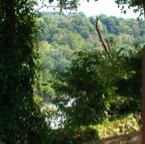
Terrace communities are those at higher elevations along the river that flood less frequently—anywhere from every few years to more than 25 years. In the Potomac Gorge, there are four types of globally rare terrace communities. The ones most compromised and threatened are the xeric, or dry, terrace communities found on bedrock outcrops and overhanging cliffs. They support the dry grassy savanna plants clinging to bedrock and the bedrock forests on the rim of the Gorge. The big challenges facing these communities come from the two big mammals who frequent the Gorge: deer and people. Deer over-browsing makes it difficult for native plants to mature and reproduce, opening the way for non-native plants to proliferate. The challenges from people relate to the placement of facilities. Built structures, parking lots, even foot trails fragment one part of a plant or forest or terrace community from another. If you’ve ever driven on an interstate highway through a city, you can see how a road can divide a neighborhood. Neighbors who once lived a short block apart, now might have to travel many blocks to cross an overpass just to say hello. This type of fragmentation is happening throughout the Gorge’s parks and trail networks. Roads and buildings fragment natural communities, making them weaker and less able to withstand stress. Informal trails damage the forest floor, causing more fragmentation. Planners must keep this in mind as they design trails and develop new structures, and when opportunities arise to correct past mistakes. |
Last updated: April 10, 2015
